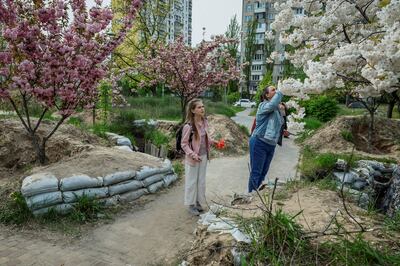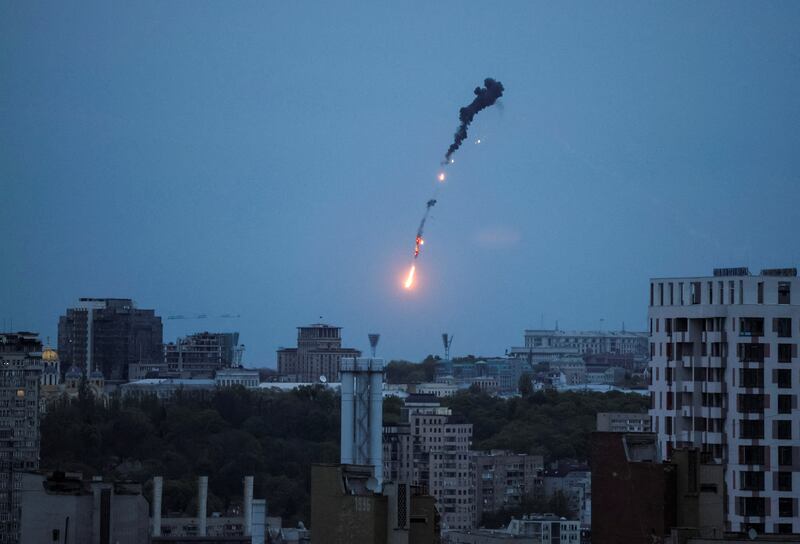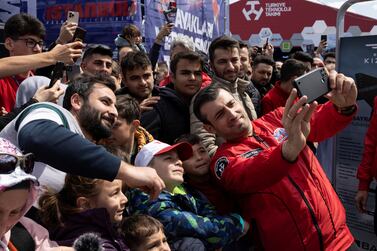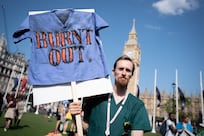Returning to Kyiv last week after months away, I found the Ukrainian capital alive with the first warm days of the season. The city’s famed chestnut trees were in bloom and crowds filled the sidewalks amid reports that the population has returned to pre-war levels.
With the curfew extended to midnight, evenings are also abuzz. The day I arrived in town I met friends for outdoor drinks and dancing late into the night. A few days later Jamala, the Crimean Tatar singer who won Eurovision 2016, played with the national symphony orchestra at Kyiv’s opera house. But all that normality was shattered with a series of blasts over central Kyiv in the wee hours of Thursday.
Ukraine’s defences had shot down more than a dozen Russian drones, I later learnt, and the days of fierce fighting may have finally returned.
Russia has controlled 17 per cent of Ukrainian land since November, according to western analysts, and with neither side willing to negotiate, the conflict had essentially reached a stalemate. Consider that we’re nearing mid-May and no sizable chunk of territory has changed hands this year.
Weather is partially to blame. Ukraine’s unusually wet spring halted its long-awaited counter-offensive before it began. The Dnipro river, which hit a 30-year low last winter after Russia damaged a major dam, has overflowed its banks in several parts of Kyiv.

A deep, swamp-like mud covers much of the country’s east. “It jams weapons and steals the boots from soldiers’ feet,” The New York Times reported last week. “Wheels and treads spin and spin, only digging military vehicles deeper into the mire.” Videos on social media show Ukrainian troops endeavouring to pull their own tanks out of knee-high muck.
To be clear, major bombings and exchanges of fire have continued. But with Ukraine’s counter-offensive on hold and Russia saying it has no plans for a major offensive, frontline fighting seemed to recede into the background.
Lately it’s been more a conflict of posturing and persuasion, need and narrative, as tensions build towards a boil. Yevgeny Prigozhin, head of the Russian paramilitary Wagner Group, underscored these pressures in Telegram videos last week. He threatened to withdraw his forces from Bakhmut on May 10, the day after Russia’s biggest military holiday, if Moscow failed to provide adequate support.
Many have argued that Russia wanted full control of Bakhmut by May 9, so as to have a win to celebrate on Victory Day, which is marked by a massive parade on Red Square. In fact, hours after Mr Prigozhin’s withdrawal threat, Russia lit up much of Bakhmut with incendiary bombs, hinting at a new scorched earth approach. However, the next day Ukrainian forces blunted Russian assaults on several areas of western Bakhmut, before the Kremlin reportedly vowed to send Mr Prigozhin all the weapons his unit needs.
Yet the shift to a new fighting phase likely started a few days before, with duelling rogue drones over the combatants’ capitals. After two drones exploded over the Kremlin last Wednesday, Russia charged Ukraine with attempting to assassinate President Vladimir Putin.
Russia later blamed the US for the attack, while its critics said Moscow had staged the attack itself to frame Kyiv. As that he-said she-said raged, central Kyiv stared down its own surprise drone threat. Late Thursday afternoon, as countless TikTok videos attest, a Turkish-made Bayraktar TB2 zipped over Independence Square before being blasted into a fiery blaze, spurring oohs and aaahs as at a fireworks show.
Ukraine’s military later acknowledged downing its own drone and said it would investigate how it came to be flying over Kyiv. Ukraine was soon able to counter-balance that gaffe with the news that its air force last week shot down Russia’s supposedly unstoppable Kinzhal missile over Kyiv.
An American-made Patriot missile, which only arrived in Ukraine last month, had intercepted the Kinzhal, which many analysts saw as beyond the capabilities of air defence systems due to its hypersonic speed. This strike upended that thinking and surely gives Ukraine confidence as it readies its counter-offensive.
The question now is, which bit of territory will Ukrainian forces target? Some say the focus will be on the Zaporizhzhia region, from which Russian occupation authorities began evacuating civilians this week. Others are convinced Ukraine aims to retake parts of Donetsk and Luhansk that Russia has held for nearly a decade.
The pressure on Kyiv is massive, particularly considering the spectacular success of last year’s counter-offensive. Should this one fail, or even fall short, western support could sag, potentially dooming Ukraine to defeat. For this reason, Kyiv is probably readying a bold move that could decide the war. Analysts have in recent days begun talking up Ukraine’s counter-offensive as potentially stunning and historic.
My best guess is that Ukraine will soon launch a massive assault with the ultimate objective of retaking Crimea. It could start on Victory Day, when the Kremlin will be pre-occupied with pageantry, or soon after.
The likeliest route is to push south of the Dnipro from Zaporizhzhia towards Melitopol, aiming to secure control of the nuclear power plant, sever Russia’s land bridge to Crimea and isolate the peninsula. Ukraine might then inch west, take control of all routes in and besiege Crimea until Russia breaks.
Russia’s 2014 annexation of Crimea helped rejuvenate Mr Putin’s presidency and was seen as a significant win for Moscow; losing it would be a major blow. Russia has in recent months built a maze of trenches along the peninsula’s northern rim, suggesting it expects to defend Crimea soon.
Ukrainian leaders have repeatedly made clear that Crimea is non-negotiable and the government is known to have developed plans and established working groups for its de-occupation and reintegration. Ukrainian drones have in recent days mounted three separate attacks on Russian targets in Crimea, probably to test their foe’s defences. The spokesperson for Ukraine’s southern command described the strikes as “preparation for the broad, full-scale offensive".
Kyiv woke yet again to air-raid sirens and explosions on Monday, the start of what should be Ukraine’s week on the world cultural stage as host of Eurovision. Instead, this year’s event is in Liverpool, where Jamala will play her new album – Qirim (“Crimea”), to which 80 Crimean musicians contributed – live on Thursday.
One way or another, Crimea may soon loom large.






